



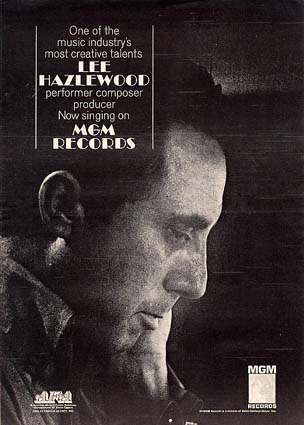
Lee à été de nouveau rappeller sous le drapeau, dans la guerre de Corée.
Où il à servi en tant que disc-jockey à la radio "AFRS Milliarie" au Japon et en Corée.QUand il quita l'armée en 1953, il décida s'arrêté ses études et passa quelques temps avecNaomi à Los Angeles, où Lee assista au cours de "Spears Broadcasting School" pour parfaireses compétances en disc-jockey.il devient disc-jockey à la radio "KCKY Coolidge"(Arizona)dans une petit village de 4 000 habitants, Lee y gagne 40$ par semaine pour ce job.
Lee y développa son propre style à l'antenne avec l'aide de plusieurs personnages.dont il pré-enregistrai sa voix sur band magnétique.Notament comme camarade d'antenne un certain Gabby Hayes nommé EB X Preston.
le début de la carrière de Lee au milieu de l'industrie du disque commença en faitepar la visite fréquante à la radio "KCKY Radio Station" par le jeune Duane Eddy, fraichementarrivé de Bath (New York) que son père travaillait au "Safeway store".Duane les fréquante visite à la station, lui demanda à lee de venir l'aider au magasin pours'occuper du rayon de disque "Country", qu'il recevait régulièrement.Malgère les vole régulière de Lee, au Magasin, Duane et lee devienne de bon amis.
l'amitié évolua rapidement, Duane jouant à la guitare sur KCKY avec un copain d'écoleJimmy Delbridge au piano.Lee les fesant jouer à la radio avec les "Louvin Brothers Harmony vocal" et terminant surune performance chaque semaine de 15 minutes.Du duo, sont passée par un groupe "Pinal Country Twisters", après beaucoup d'encouragement du patron de Lee.EN 1954, Lee conduira souvent Jimmy et Duane à Phoenix(pour se produire), a bord de sa Pontiac,aussi pour les samedi soir concert au "Madison Square Garden".lors de ces concerts, Lee et Duane rencontère Al Casey qui jouerait de la Guitar élétrique,dans un groupe, "The Sunset Riders".
Durant l'année 1953, tout en travaillant à la radio, il commença à écrire quelques textes de chansons. sa première chanson fut enregistrer avec BMI "Four bell love alarm\' en Novembre 53.au milieu de l'année 1955, le trio enregristra au Ramsey's Records à Phoenix "I want some lovingbaby" et "Soda Fountain girl".Hazlewood il pailla 150$ pour le pressing au Preston Label à travers le "Four Star Records"à Los Angeles.
En 1955, il débute comme DJ à la Radio KRUX à Phoenix en Arizona après avoir été congédié par KCKY Coolidge la veille.
en fin d'année 1955, il créa un nouveau label "Viv Label" pour promovoir ses productions, ses écritures, ses arrangement, performance et ses découverte. Carrière qu'il ne céssera jamais à continuer juqu'en 2002.
Lee changa souvent de domicile, de 1968 à nos jours, il véçu entrela californie, Londres, Paris, Stockholm, Hambourg, Helsinki,l'Irlande, l'espagneLas Vegas, Phoenix (Arizona), le Texas et la Floride.il termina sa vie à proximité de Las Végas, Henderson (Nevada).
En 2005, les médecins on lui diagnostiqué un cancer des rein. Après une lourde intervention chirurgicale pour supprimer l'un de ses reins,Lee pris la décision d'enregrister son dernier albums solo avec ses vieux compagion de routes,album publié en 2006, intiulé "Cake or Deah".
le 4 août 2007 est venue la triste nouvelle que lee décède à l'age de 78 ans, après une lutte de 3 ans contre le cancer.
Lee Hazlewood a commencé sa propre carrière sous le lable Viv Record Debra Publishing Company à Phoenix en 1955. Viv Le nom a été repris d'une ligne de produits de beauté populaire favorisée par sa femme Naomi. Il avait travaillait à son domicile au 11 Drive. Avec l'aide de Ray Odom ils enregistraient les chanteurs, qu'il avait rencontré au Madison Square Gardens, à Phoenix et a utilisé le groupe maison Le Sunset Riders que le backing band. Leur chef, Al Casey, devrait faire plusieurs préparait plusieurs dossiers pour Highland, MCI Et Stacy Records sous la direction de Lee.
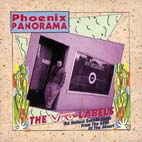
À la fin de 1955, sa maison était pleine de disques de 78 tours et 45 tours du lable blanc et noir mettant en vedette des chanteurs tels que Jimmy Spellman, Jimmy Johnson et Loy Clingman. (Ces chansons et bien d'autres peuvent être entendues sur le coffret 3CD «Phénix Panorama, Le lable Viv publié en Allemagne en 1995 par Bear Family Records BCD sur 15824 CI)
Début de 1956, il y avait non seulement plus les sessions, pour le label Viv de Lee, mais aussi la nouvelle composition "The Fool ".Comme Al Casey raconte: "Lee a toujours dit que c'était une simple chanson country, mais avec la guitare lécher elle a changé le son. J'avais été à l'écoute d'un mec avec le nom de Hubert Sumlin sur "Howlin "Wolf's classic record" Smokestack lightning " . Je viens de modifier un peu pour "The Fool" et tout d'un coup, il n'est pas de pays plus. Il a surpris tout le monde, surtout Lee. Casey a suggéré de Lee que son ami depuis l'école primaire, Sanford Clark, pourrait rendre justice à sa chanson.
Sanford est né le 24 octobre en 1935 à Tulsa, en Oklahoma et a déménagé à Phoenix, en Arizona quand il avait 9 ans.Il a conseillé à Lee d'aller l'écouter à l'auditorium de Phoenix. Lee a aimé ce qu'il fesait et juste une semaine plus tard, il a pris Sanford et Al Casey's Ramsey Floyd au minuscule studio d'enregistrement à Phoenix "The Fool". Les autres ont été accompagnateur, Corky Casey (Al's wife), le rythme de la guitare acoustique, Jimmy Wilcox à la basse et Connie Conway à la batterie.
en mars 1956 Lee a passé un accord avec les propriétaires (Jimmy Wilcox, Connie Conway et Floyd Ramsey) du petit label MCI, qui loue des locaux à côté de la Enregistreurs Ramsey, à libérer sa nouvelle composition en contrepartie de la moitié de l'éventuelle publication de revenu.
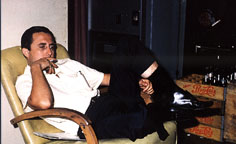
Lee créditera de la balade "The Fool" par sa femme Naomi Shackleford sous le nom de Naomi Ford parce qu'il était préoccupé par le fait que comme un DJ ne pourrait pas jouer le morceau dans sa propre station de radio. La chanson est un mélange du style d'Elvis Presley et Johnny Cash fait mais quelques peu différentes. Avec un fort air de mystère à ce sujet et Sanford's flat, laconique, la voix qui s'imposer comme Casey a joué, la guitare hurlant du Gretsch Country Club. Pour le tambour, ils ont utilisé un petit morceau de bambou de la scission, qui a été jetant dans la rue et il bat à la guitare. Ils ne pouvaient pas obtenir le son de la batterie afin de frapper la coquille dure guitare affaire. Ils ont fait plus de 100 prises avec Casey's profonde guitare acoustique et Sanford's'avant que lee ne soit satisfait. On se demande combien de chansons ont été inspirée par les musque d'Elvis tel que "Mystery train" et "Heartbreak Hotel", Lee Hazlewood influencé le concept de la manière dont sa chanson doit son. Il dira plut tard à ses amis, il a été surpris quand le titre à été jouer. Les trémies à grain écho seront la marque de fabrique de Lee Hazlewood pour les prochaines années. Cette session a marqué le véritable début de la scène musicale de Phoenix.
En mai 1956, la chanson a été sortie avec l'autre titre: "Lonesome for a letter", un titre qui ressamble à du Elvis Presley, sur la face B(MCI 1003). Quelque 500 maquettes ont été envoyés aux stations de radio, mais c'est tombé dans l'oubli jusqu'à ce que le Cleveland Bill Randall DJ de la station de radio aimait suffisant pour l'envoyer à Randy Wood, président de Dot Records. Ils ont appelé M.C.I. À Phoenix et on fait un marché avec Lee. Sanford signé avec Dot Records, en passant sur les sous-commission de Corail et Decca. Dot re-publié "The Fool" et en août 1956, le titre arriva Numéro 7 dans les charts et été vendu à plus 800 000 exemplaires.
Elles ont besoin d'un suivi unique et de la prochaine session, le 9 juin a produit trois très différentes pistes: "Don't care", "Usta be my baby" et "Why did I ever choose you". Only "Usta be my baby"a été libéré, mais comme un revers de' A tricher" qui a été enregistré en octobre 1956. "A cheat" méritait un meilleur sort que ce qu'il a reçu. Il avait le même air de mystère sombre "The fool" avait. À la même session, ils ont coupé le unissued dossiers "Ne pleure pas", une ballade adolescente, et "Ain't nobody here but us chicken". "don't cry" a été enregistré par Lee lui-même et publié sur le Smash label.

As Duane Eddy continued high school in Coolidge the young Al Casey became Lee's unofficial musical director. Lee added the credit 'Al Casey, guitar' on the Viv sides as well as on ‘The fool'. Al Casey says: "That was unheard of in those days, it was very nice of him because he certainly didn"t have to do it. No one else was and he did".
In fact the next M.C.I. release after ‘The fool' was Casey's version of ‘The pink panther', written and produced by Lee in July 1956.

Lee knew the more versions of a song, the better the chances for air play and publishing income. In October Lee leased the tape to Dot and that same month Clark's second single, ‘A cheat', was released and it was shortly followed by Casey's two-sided instrumental ‘A fool's blues' and ‘Juice'. By the end of 1956 the money for ‘The fool' started coming in and Lee knew that his writing, publishing and producing efforts were going to pay the bills.
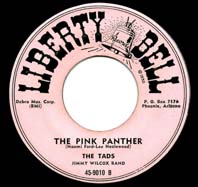
Lee hired his own promotion man, John Garton in Los Angeles, to work his releases. He secured a release of the Debra copyright, ‘Why did I choose you', for a Pat Boone EP and in January 1957 Dot offered him a non-exclusive producer position in their R&B division. By March 1957 the Hazlewood family moved to the West Coast and Lee got an office on Melrose Avenue.
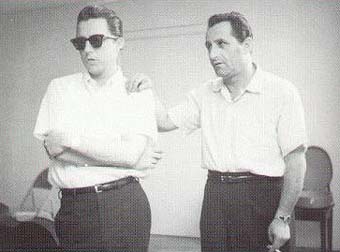
He was looking for money to go to Phoenix and record a couple of acts and I had a good relationship with the Bihari Brothers at Modern Music so I went over and talked to them and they gave me $800 for, I think, eight sides. Lee and I got to Phoenix and that's when we got together. I met Duane Eddy, Al Casey, Bob Taylor and Buddy Wheeler.
Before we took the trip Lee and I formed Gregmark Publishing. My son was Greg and Lee's was Mark. Lee was working for Dot and wanted to keep as much of his publishing as possible and Randy Wood didn't mind.
So we started putting records out on other labels that Dot passed on but we had the publishing". This was the birth of Sill-Hazlewood Productions. Now Lee had someone to do the day-to-day business while he could focus on writing and producing.

Lee Hazlewood had a group of players that could play until he was satisfied. The basic team of players was Al Casey on guitar, bass, piano; the late Donnie Owens on rhythm guitar; Buddy Wheeler on electric bass; Jim Simmons on acoustic bass and Bob Taylor on drums.
Shortly after the release of ‘The fool' Lee told Floyd Ramsey he needed a better echo effect like that of the Los Angeles studios. They located a few grain tanks locally and Casey remembers tagging along with Floyd and Lee. "Lee yelled into each tank listening for the right sound". They bought a tank for $200 and placed it outside the tiny studio. The engineer, Ray Stouffer, put a microphone and a small speaker inside the tank to produce a second source of echo that they could mix with the tape recorder echo. As Ramsey recalls: "I didn't have the cash at the time and I told Lee that I would give him $300 worth of studio time if he would loan me the money". Ray Stouffer left shortly after setting the whole thing up and Jack Miller took over the engineering at Ramsey\'s Recorders.
"The first time I met Lee I had just been hired by Floyd at Ramsey's Recorders but I was working next door at Ramsey's Radio and Television in the repair shop. Floyd called me up at home and said we have a session here tomorrow and I'd like you to do it. I said ‘O.K.' and showed up the next morning. I was in the studio with Floyd when the lady singer showed up and she had a little poodle with her. I don't remember her name and shortly after Lee comes in. Lee said ‘who's this' and Floyd said ‘this is my assistant engineer Jack Miller' to which Lee replied ‘The only thing I hate more than assistant engineers are damn poodles'. That was my first impression of Lee".
With the success of ‘The fool' came more business and Ramsey did new investments in his little studio with new equipment and construction. Ramsey's stayed busy with the commercial demands of local advertising agencies. They were also cutting all the master lacquers for the Wakefield Pressing plant.
The months Lee spent at Dot were very frustrating for the productive Arizona transplant. During 1957 most of his creative efforts were released on other labels. "Dot never put out anything I wanted to for a year", Lee says. "When I played Duane for Randy Wood he said it sounded like someone trying to string wire across the Grand Canyon".
To settle a dispute over ‘The fool' publishing royalties, Loy Clingman became 100% owner of the Viv/Debra assets by the middle of the year 1957 and Lee's direct involvement was over. He still received royalties on the songs he wrote for Debra Music however. Later Clingman would find new partners, build a studio and sign a new roster of singers to the Viv label. Randy Wood had his own ideas about the type of music he wanted to be issued by Dot. He wanted Sanford to make recordings in the Pat Boone style but he did not like that.
Al Casey who later on worked with Randy Wood on his Ranwood label to do the 'Exotic Guitars' pop instrumental LP's says Wood felt he could get more sales by drawing on straight pop tunes. Late 1956 and early 1957 the final Phoenix sessions for Dot Records produced Lee's excellent composition ‘Ooo baby' and a credible version of Merle Travis' ‘Nine pound hammer'. Most of the Hollywood sessions, which started in March 1957, produced many unissued songs which were issued for the first time in 1986 in Germany by Bear Family Records. They are a curious mix of excellent songs that should have been issued before and nondescript material.
Even with Randy Wood's experiments Sanford made some excellent recordings such as 'Lou be doo', a slick rocker with a smooth vocal chorus and a hot saxophone solo, 'A cross eyed alley cat', which is an example of the strong influence Sanford had on Ricky Nelson. ‘Love charms' was close to ‘The fool'/'A cheat' style.
In November 1957 Sanford recorded Lee's ‘The man who made an angel cry', which was done in that Johnny Cash style. The final song Lee and Sanford recorded for Dot was ‘Travelin' man', a song with a sloppy out-of-tune vocal chorus. In early 1958 they signed with Jamie Records, the label for which Lee produced also Al Casey's friend Duane Eddy's ‘Rebel rouser' and ‘Forty miles of bad road'. In May Lee and Sanford went back to Floyd Ramsey's audio recorders in Phoenix to record ‘Still as the night' and ‘Sing ‘em some blues' with Duane playing his twangy lead guitar. It did not become a commercial success however.
In the spring of 1959 ‘Bad luck' and ‘My jealousy' were issued and again they were no successful. At the next session in May of that year two of Lee's compositions were recorded namely 'New kind of fool', which was a new attempt to cash in on the ‘Fool' formula, and ‘Run boy run'. Especially ‘Run boy run' could have been successful but the time it was brought out was not chosen well as did Lee's composition ‘Son of a gun' recorded in October 1959.
The last session for Jamie took place on March 17, 1960 and was interesting for the growling distorted guitar sound Al Casey developed. As Al explains "Lee knew a guy who worked at a radio station and he built a little box for that. This happened before all the fuzz tones. We were trying to get a good, nice clean sound. Lee wanted the distorted sound."
The Jamie recordings were all commercial failures. A few however reached the lower part of the Billboard charts but did not get the attention they earned.
When Sanford left Jamie he made two records for respectively the Trey and Project label both owned by Lee in 1961 and 1962. The latter is a much sought after item by the collectors of Sanford's records. These were not a commercial success.
Lee and Sanford tried again at Warner Brothers Records in 1964 and 1965 and released two singles.
In 1965 he nearly had a hit recording of Lee's composition 'Houston'. This country-folk flavored number, which Lee himself included on his ‘Friday's child' album in 1964, caused some bitterness to Sanford after Dean Martin covered it that year and released it on Reprise. Lee produced it for Dean and the DJ's quitted playing Sanford's version. However it was a number one hit in Texas. As Sanford declares he and Lee are still friends though he is still clearly stung by lost opportunity. In 1966 Sanford signed with the Floyd Ramsey owned Ramco Records and released 5 singles between 1966 and 1968. The first recording was a remake of 'The fool' called 'The fool 66' with the former Ramco artist Waylon Jennings playing the leading guitar role.
As Sanford says: "I knew Waylon before he ever cut a record. Ramco wanted to try something else and I could not get the sound there. Floyd Ramsey's son produced those sides and they were just looking for another fluke like 'The fool'. They cut twelve sides and that fluke never materialized". Lee and Sanford stayed in touch and Sanford made some records for Lee's LHI (Lee Hazlewood Industries) label. Sanford was not pleased with the sessions he did for the label. "Lee would call me from Los Angeles and find out the keys I would do so and so in. He'd send me the music and stuff and I'd call him and tell him the key and they'd already have the tracks cut and then what they would do is add something later on and that's one reason they felt they didn't work. They just weren't live".
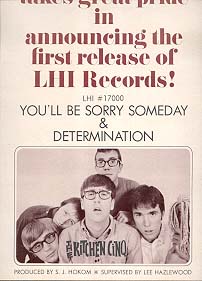
He has not stopped recording then. In 1982 he got back in Lee's own Criterion studio in Los Angeles with Lee and Al Casey and recorded amongst others some of Lee's compositions like 'A taste of you' and 'Feathers'. They were never released and Sanford sent them to Lee's former partner Lester Sill, who was at Screen Gems Music at the time, but nothing happened. Finally he sent two tracks to Nashville and released them on his own Desert Sun label though without any major success.
It caused a bitter disappointment to Sanford both emotionally as financially. In 1993 Bear Family Records in Germany released the 1982 recordings on a CD.
Lee had his own idea of a guitar sound and wanted to achieve a strong, low, full and swinging tone corresponding with the low piano tones played by Eddie Duchin several years ago. The guitar should be the voice of the otherwise instrumental pieces and he started experimenting echoes on country sounds with session guitarist Al Casey.
But Al Casey wanted to play like his great idol Chet Atkins and was in no way ready to accommodate Lee's ideas. They split up but not before Al introduced his rhythm guitarist's name of Duane Eddy into the conversation. Lee arranged a studio session and since Duane wasn't so set in his ways as Casey, Lee had precisely the right man he wanted.
Duane Eddy was born on 26th of April 1938 in Corning (New York State) and moved with his family to Coolidge (Arizona). He was given his first guitar at the age of five and with much encouragement from his father Lloyd, who was a musician himself, he learned to pick all the country songs he heard on the local radio.
By the age of thirteen he was playing guitar in local bands and at seventeen he teamed up with his fellow school pal Jimmy Delbridge and appeared at local dances in and around Coolidge, Arizona. The pair made their radio debut on radio KCKY in Coolidge with a regular Saturday evening spot featuring mainly country songs. In 1956 the pair made their progression to television appearing on KTVK in Phoenix, Arizona on their own show called 'The Hit Parade'.
Such was their success that many fans demanded a record release, so Jimmy and Duane together with Buddy Long & The Western Melody Boys went along to Audio Recorders in Phoenix and cut a song written by Lee titled ‘Soda fountain girl', which was issued on Preston (212) in the Phoenix area only in 1956.
After speculating with several groups Duane finally ended up with Al Casey. Casey's band toured the so-called nightclub circuit playing throughout the small clubs in California. Duane played rhythm guitar in this band and the repertoire consisted mainly of country and western, some rhythm and blues and populair hits of the time. Amongst the pop hits naturally were rock and roll songs but Duane's great preference at that time was for C & W pieces. It was inconceivable at that time he would become a great rock and roll guitarist.
Duane's next 'recording' was ‘Ramrod' backed with ‘Caravan'. The record was only issued on the Ford (500) label in Arizona in 1957. In this way he moved away from the pure country sounds. Although all credits were given to Duane it was in fact Al Casey who played on these sides and certainly not Duane.
He could finally identify himself with the ideas of Lee in developing the technique of playing a deep twangy sound on the bottom strings of the instrument. They recognized the commer cial potential. So the first single titled ‘Moovin' 'n' groovin'‘ as produced. Lee however could not sell it to the big record companies. They did not believe in instrumental hits and gave all their interest on rock and roll singers. It was the heyday of Elvis Presley, Little Richard, Buddy Holly, Eddie Cochran and Jerry Lee Lewis. Besides, there were sundry singers of dreamy ballads like Dion & The Belmonts, Frankie Avalon and Johnny Tillotson. On the country scene Chet Atkins was king of the guitar and other guitarists were given no chance.
Therefore Lee had to try his luck with the smaller companies and finally he leased it to Jamie Records, a Philadelphia company which occupied itself mainly with rhythm and blues repertoire. The Jamie company had already had local hits but the big business was to come with Duane, as artist and Lee, as resident producer. 'Moovin' 'n' groovin'' was released in 1958 with as the B-side 'Up and down', which was already produced by Duane and Lee. Within a short time the record was a local hit followed by a national hit and climbed into the official Billboard charts.
The 'twangy' guitar sound had excited attention but Lee and Duane discussed a follow-up which became a joint composition: 'Rebel rouser'. This became the first real hit single for Duane and was a top ten hit in the US in the summer of 1958. Some months later it even got the attention in Europe.
Lee and Duane then decided to form a backing group to make tours and TV appearances. Since Duane had got on well, both socially and professionally with the old members of the Al Casey band, it was a natural progression to take over the hardly altered band. They agreed to call themselves 'The Rebels' in dedication to 'Rebel rouser' and so the label credits them Duane Eddy, his 'twangy' guitar & The Rebels. Al Casey (piano), his wife Corky (rhythm guitar), Buddy Wheeler (bass guitar), the late Steve Douglas (sax) and Mike Bermani (drums) became members of Duane's band for recording sessions. The touring Rebels consisted however of Steve Douglas (sax), Ike Clanton (rhythm guitar) and Mike Bermani (drums). But these line-ups changed over the years.
After Duane played 'Ramrod' on the Dick Clark TV show as an encore the Jamie Record company received lots of enquiries about the track and so the Al Casey composition with as B-side 'The walker' were selected as the follow-up single to the superhit 'Rebel rouser'. To cash in immediately on the success of 'Rebel rouser' Lee took Al Casey's original 'Ramrod' version (Ford label) and re-arranged it. He made a longer version and added the saxophone and the backing group The Sharps (later to become The Rivingtons of 'Pa pa oom wah wah' hit fame). For the flip side Lee took the backing track for 'She gotta shake' by Al Casey but it is not clear if and to what extent Duane was involved.
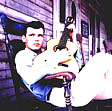
The people at Jamie were tied up with George Goldner, who was a very powerful person on the East Coast at that time, and when he saw what Jamie did with 'Ramrod' he realized he had the basic Ford track and rushed that out to beat Lee and Jamie's version on to the market.

Successes that followed were ‘Cannonball' (1958), ‘The lonely one' (1959), ‘Yep!' (1959), 'Forty miles of bad road' (1959), ‘The quiet three' (1959), 'First love, first tears' (1959), ‘Some kind-a earthquake' (1959), ‘Bonnie came back' (1960), ‘Shazam' (1960), ‘Because they're young' (1960), ‘Kommotion' (1960), ‘Peter Gunn' (1960), ‘Pepe' (1961), ‘Theme from Dixie' (1961), ‘Ring of fire' (1961), ‘Driving home' (1961) and ‘My blue heaven' (1961) on Jamie and ‘Deep in the heart of Texas' (1962), ‘Ballad of Paladin' (1962), ‘(Dance with the) Guitar man' (1962), ‘Boss guitar' (1963), ‘Lonely boy, lonely guitar' (1963) and 'Your baby's gone surfin'' (1963) on RCA Victor. Nearly all the Jamie and RCA Victor recordings were (co-)produced by Lee. He also produced the Reprise and Colpix albums for Duane.
In 1977 Duane was back in the charts with the classic 'You are my sunshine' backed with 'From eight to seven' on Elektra records. It was the last record Lee produced for Duane Eddy and featured on the A-side vocals by Duane's wife Deed Abbate together with Waylon Jennings and Willie Nelson.
Lee influenced Phil Spector who became famous with the so-called Spector ‘wall of sound' and worked also with Jack Nitzsche. He founded the Gregmark recording company with Lester Sill. Other labels Lee founded were Trey, East West and LHI (Lee Hazlewood Industries) but they became unsuccessful.
From 1961 till 1964 he produced records with the Paris Sisters, a singing trio from San Francisco, Dean Martin who decided to record twoof Lee's compositions, the worldwide hit success 'Houston' and the minor hit 'Shades' and drummer Hal Blaine who recorded some of his compositions for his singles and 1963 album 'Deuces, 'T's', roadsters and drums'. From 1964 till 1966 Lee produced at the request of producer Jimmy Bowen of Reprise Records hits for another trio with the names of Dino (son of Dean Martin), Desi (son of Desi Arnaz and Lucille Ball) and Billy (Hinsche). They charted with singles like 'I'm a fool' and 'Not the lovin' kind'. Lee produced four albums for Dino, Desi & Billy: 'I'm a fool' (1965), 'Our times are coming' (1966), 'Memories are made of this' (1966) and 'Souvenir' (1966).

As a new challenge and maybe to fight back against the British rock invasion Lee started to help Nancy Sinatra on her singing career in 1965. Nancy (Sandra) Sinatra was born on the 8th of June 1940 in Jersey City, N.J. and began to start making records on father Frank's Reprise label in 1961. In the US she was quite unsuccessful with songs like 'Cuff links and a tie clip' and 'Like I do' but in many countries these songs were highly appreciated reaching high chart positions. Jimmy Bowen and Mo Ostin of Reprise Records asked Lee to work with Nancy to help salvage her career and after being convinced in a meeting with Nancy and Frank Sinatra Lee signed.
Lee lowered her singing voice a key and a half to make her voice sound more impressive and produced a string of hits for her on Reprise records that started off with the minor hit single 'So long, babe' in 1965. Soon they hitted the charts firmly with the sensational 'These boots are made for walkin'' (1966) which reached a number 1 position in the US and many other countries.
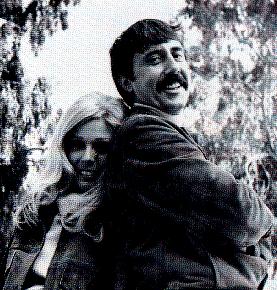
The LP 'Nancy and Lee' contains only duet songs and reached a no. 13 position in the US in 1968. Lee and Jimmy Bowen were also involved in the production of 'Something stupid', a duet recording of Frank and Nancy Sinatra released as a single on Reprise records.
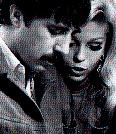
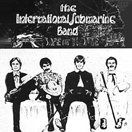
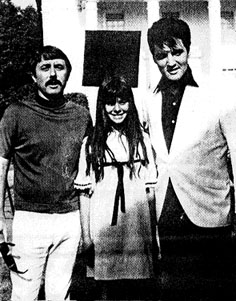
In the rock and roll movie ‘Because they're young' (1960) Duane Eddy had a role and played with The Rebels the title song and ‘Shazam!', which was co-written by Duane and Lee.
Lee was an actor himself in three movies. In the film ‘The moonshine war' (1970) he got a role together with well-known stars like Patrick McGoohan and Alan Alda (See photo on right side).
The soundtrack album was released on the small Swedish Viking label and contains eight vocal tracks by Joe Cannon and two instrumental tracks. Six compositions are by Lee Hazlewood. This album is a hard to obtain item now.
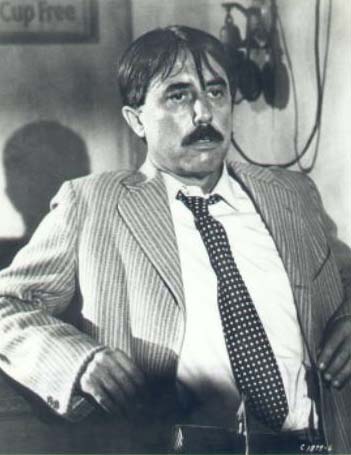
None of the early hits have been written for Lee himself. That does not mean that Lee is not a singer. Besides his work with record producing, talent discovery and songwriting he's a singer too. His first recording ‘Five more miles to Folsom' dates from the middle of the fifties and was ssued for the first time in 1995 on the German Bear Family 3CD box ‘Phoenix Panorama - The Viv labels'. From 1958 dates 'Pretty Jane'. This Jamie recording is backed with 'Want me'. The labels credit the songs to Mark Robinson but in reality this is Lee. From these nice rockabilly styled songs has been made a re-issue on the TeeGee and Bison Bop labels.
The backing band consists of Duane Eddy (lead guitar) and other members of The Rebels. In 1960 Lee again recorded two songs for the Jamie label, namely 'The girl on death row' from the motion picture 'Why must I die?', which was originally written for Sanford Clark but was never issued and 'Words mean nothing'. Again Duane Eddy and The Rebels do the instrumental backings.
Two nowadays scarce recordings have been cut by him in 1961 on the Smash label called 'Della' and 'Don't cry (no more)'.
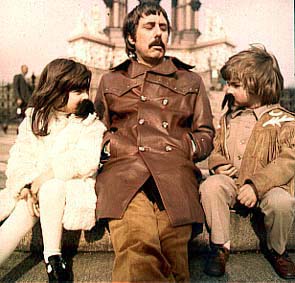
The album from which there are versions with a book cover had been issued in Europe on the London label. A re-issue with a tasteful book cover on Lee's own LHI (Lee Hazlewood Industries) label was out in 1969.
Lee also appears on the Mercury and Capitol recordings by the Los Angeles based group The Shacklefords, named after his first wife's family name of Shackleford. Besides some single records they cut two albums.
In 1963 they recorded 'Until you've heard The Shacklefords you ain't heard nothin' yet' with instrumental backing by James Burton, Al Casey, Billy Strange and Hal Blaine amongst others.
In 1964 Lee signed to Reprise and made another album in the style of 'Trouble' titled 'The N.S.V.I.P.'s'. The guitar playing behind Lee was now done by Al Casey. This album was re-issued in Western Germany in 1969. However the information on the cover shows some incorrect information.
In 1965 the album 'Friday's child' was issued, which includes the Dean Martin chart success 'Houston', the Sanford Clark hit 'The fool' and 'I'm blue' which was penned by Mirriam Johnson, Duane's wife who later on started a singing career as Jessi Colter and married Waylon Jennings.
A nine tracks budget re-issue of this album was made for Harmony records in 1968.
In 1966 Lee again changed record company and signed to MGM. In the same year two albums were issued: 'The very special world of Lee Hazlewood' and 'Lee Hazlewoodism, its cause and cure'. They contain some songs that were originally written for Nancy Sinatra ('These boots are made for walkin'', 'So long, babe' and 'In our time') and Dino, Desi and Billy ('Not the lovin' kind'). The songs on these two albums were conducted by Billy Strange and feature Suzi Jane Hokom on three tracks.
In 1967 Lee presented the bizarre and exotic '98% American Mom & Apple Pie 1929 Crash Band' album issued on his own LHI label. The album is filled with eleven instrumental versions of his own compositions like 'Summer wine', 'These boots are made for walkin'' and 'Houston'. This much sought after item is a unique concept because of the unusual instruments (e.g. Al Casey played kazoo) and the way Lee arranged these chart toppers.
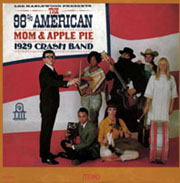
In this period a number of compilation albums such as 'This is Lee Hazlewood' and 'These boots are made for walkin'' were issued by MGM.
In 1968 Lee then switched again to Reprise Records which was the company he produced records for and did some successful duets with Nancy Sinatra in 1967 and 1968 as a follow-up to her personal hits. Songs like 'Summer wine', 'Lady bird', ‘Some velvet morning' and ‘Sand' reached high chart placing nearly all over the world. From these hit songs the famous ‘Nancy & Lee' compilation album was made that reached a high position in the US album charts in 1968. This now can be considered as a standard album. The songs were again conducted by Billy Strange.
In the years 1967/1968 Lee recorded also some songs that only were released on 7 inch vinyl such as 'Summer wine' for MGM Records that featured Suzi Jane Hokom, the Bobbie Gentry cover 'Ode to Billie Joe' and the powerful 'Rainbow woman' backed with the beautiful and moody 'I am, you are', the latter being a tribute to his daughter Debbie. Both songs are issued on Reprise Records and produced by Suzi Jane Hokom. The next outing on wax by Lee was the superb album 'Love and other crimes' which was done in association by Jack Robinson in Paris in 1968. His wife Naomi, two children Mark and Debbie and the following session musicians accompanied him on this trip: Don Randi (piano), James Burton (electric guitar), Chuck Berghofer (bass), Hal Blaine (drums) and Donnie Owens (rhythm guitar). All songs are done in a bluesy way and the album contains own compositions and cover versions such like ‘Morning dew' and ‘The house song', the latter of Peter, Paul & Mary fame. The album's front cover shows a poor quality photo of Lee that contrasts strongly with the superb song quality.
In 1968 Lee did his first TV special for Swedish TV titled 'Love and other crimes' with the help of Donnie Owens (guitar) and Swedish singer Siw Malmkvist (duets). The year 1969 brought us two fine albums on his own LHI label: 'The cowboy and the lady' and 'Forty', which was made at the opportunity of reaching the age of forty.
'The cowboy and the lady' contains duets with singer/actress Ann-Margret (real name Ann-Margaret Olsson) and also solo pieces by Lee and Ann-Margret. The album has a great and therefore unusual book cover, which shows Lee and Ann-Margret in three successive scenes. None of the recorded songs were composed by Lee himself. Some of them were also issued on single like 'Dark end of the street', 'Victims of the night', 'Greyhound bus depot' and 'No regrets'. 'Forty' is another solo album which shows the versatility of Lee but most of the songs were done in a subdued mood like 'Paris bells', 'Mary', 'September song' and the real gem 'What's more I don't need her'. The recordings were done in London and produced by Shel Talmy. Lee included two Randy Newman compositions on the album which are in a strong contrast to the mood of it and the reasons to include them are not quite clear to me. The book cover shows Lee lying in a garden swing but the quality of the picture is worse as if it was taken by an amateur photographer and in great contrast with the outstanding tracks of the album.
In the beginning of the 70's Lee became a sort of a bohemian and decided to leave the US. He changed homes between Sweden, Paris and London. In 1970 Lee made his first album in Sweden titled 'Cowboy in Sweden', which was also issued in the US and was made at the occasion of a TV special Lee made for Swedish television in collaboration with Swedish film maker Torbjörn Axelman, Lee's children Debbie and Mark Hazlewood, Suzi Jane Hokom, Swedish singer Nina Lizell, Lena Edling from Sweden, the George Baker Selection (a Dutch group), Steve Rowland & The Family Dogg and Rumplestiltskin (both UK groups).
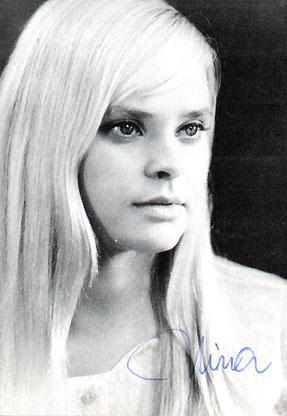
Back in the States in 1971 Lee made his first - but nowadays hard to find - album 'Requiem for an almost lady' for the Swedish Viking label. The album was also issued in the U.K. (Reprise) and Germany (RCA Victor). It has some autobiographical elements and contains some very fine songs. Part of the production was done by Suzanne Jennings. The album sleeve shows the beautiful painting 'Lady bird' by Dutch painter ARDY (Ardy Strüwer). Lee was accompanied by Jerry Cole, Donnie Owens and Joe Cannon. The album was first issued in the US by Smells Like Records in 1999.
Thanks to the success Lee and Nancy Sinatra had with the song 'Did you ever?' they made a second album - but now for RCA Victor - in 1972 in the Hollywood based studio of Frank Sinatra. The album is issued by RCA Victor and titled 'Nancy & Lee again' and includes of course 'Did you ever?' that even became the title of the German and Swedish issues.
In 1973 Lee made the 'N.S.V.I.P's' TV special in which he sang and acted with Swedish singer Lill Lindfors. Most of the lyrics are by Harry Chapin. Swedish television sent it to Montreux (Switzerland) on behalf of the 'Golden Rose of Montreux' prize and won. As Lee declares he first offered the same programme to a big US television company but they showed no interest.
Also in 1973 but in the US he cut the album 'Poet, fool or bum' for the Capitol label. This brilliant album was made by Amos Productions and consists partly of cover versions. This album has different covers for either the US and UK issue and shows Lee without a mustache, which could have been called one of his trademarks. One could think he looked like Leonard Cohen whose song 'Come spend the morning' he included on the album. The album even received a one-word verdict 'Bum' in UK's New Musical Express. The production was in the hands of Jimmy Bowen.

In 1975 Lee produced another Swedish album ‘20th Century Lee' which consists of cover versions of at that time popular songs done by Bob Dylan, Dr. Hook and others. It even contains a English/Spanish ('An old lullaby') and a Swedish song written by Evert Taube (‘Brevet från Lillan'). Again the Sanford Clark hit ‘The fool' is included on this album in the arrangements as on the ‘Friday's child' LP (1964).
Some of the session musicians like bassist Rutger Gunnarsson, guitarist Janne Schaffer and music director Sven-Olof Walldoff worked also with the Swedish group ABBA that became famous in the second half of the seventies. This rare to get 1976 German RCA Victor album shows the versatility of Lee but will never let forget the great albums he made before. From this album RCA took two songs ('Indian summer' and 'Whole lotta shakin' goin' on') for his first and only 12" maxi single.
In 1977 Lee made his last vinyl album. The album titled 'Back on the street again' was cut in Western Germany and contains some new material like ‘Dolly Parton's guitar', ‘Back on the street again', ‘Save a place for me', on which he duets with Shari Garbo, but also the Kris Kristofferson penned ‘Smokey put the sweat on me'. The backing musicians were German sessionists completed with Dutch steel guitarist Frans Doolaard. The production was again in hands of the Swedish Suzanne Jennings-Persson. This EMI album was only issued in Western Germany, Holland, Sweden and South-Africa. From New Zealand only a demo version is known so far.
The latest outings on wax in the States were the 1979 and 1980 MCA singles with the songs ‘Dolly Parton's guitar', ‘A taste of you', ‘Willie Jones' and ‘Hollywood (just ain't no place)'. Again hard to find items. Lee's first compact disc (CD) titled ‘Son of a gun' dates from around 1984 and consists of Swedish and German cuts of the seventies. This difficult to find item was issued by the German Repertoire label. From 1991 on the 60's and 70's duets with Nancy Sinatra have been issued on CD several times but no legal re-issues on CD of the original albums by Lee were located.
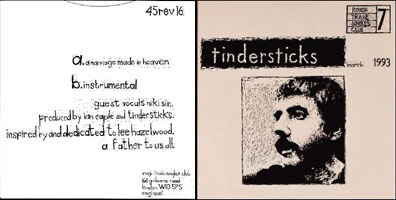

During the Nancy Sinatra come-back tour in 1995 Lee and Nancy toured through the USA, Canada and Sweden cashing in on their old success songs. The years 1999 and 2000 were important years for both Lee and his fans for the following six CD albums saw the light through the efforts of Sonic Youth drummer Steve Shelley for his independent label Smells Like Records: 'Cowboy in Sweden' (April 1999), a new 'standards' CD album of songs that were already recorded in the 80's titled 'Farmisht, flatulence, origami, ARF !!! and me...' with the Al Casey Combo (April 1999), 'Trouble is a lonesome town' (September 1999), 'Requiem for an almost lady' (September 1999), '13' (January 2000), 'The cowboy and the lady' (May 2000). Unfortunately plans for a CD with a re-issue of LHI label singles were cancelled.
Surprisingly Lee gave in 1999 his first solo performances since 1974. These outstanding concerts were given in London (28 June, Royal Festival Hall) and Stockholm (9 July, Fanclub Festival). Lee was backed by the Lasse Samuelson group from Sweden, his life-time friend Al Casey and Brad Bauder (USA).
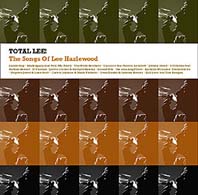
Surprisingly Gazell Records in Sweden has issued in September 2002 a similar album as 'For every solution...' titled 'Bootleg dreams and counterfeit demos' accompanied by Al Casey.
To coincide with these issues Lee made an outstanding concert tour along thirteen mayor cities in nine European countries in September 2002. He was accompanied on stage by members of the bands High Llamas and Stereolab. Most of the live tracks can be heard on the CD album 'The lycanthrope tour/Europe 2002' issued by Gazell Records (Sweden).
During the 2002 concert tour Lee unfolded his plans to record both a third duet album with Nancy Sinatra and his final solo album to be titled 'Cake or Death'. In February 2003 the takes for the duet album with Nancy Sinatra were done in Nasville with the help of well-known arranger Billy Strange. In May 2004 the album - simply titled 'Nancy & Lee 3' - was released by Warner Music in Australia only. Duane Eddy has co-written one song for the album and plays his 'twangy' guitar on the track that generally is considered as the most outstanding track of this album.

On August 4, 2007 came the sad news that Lee has died and lost a three-year struggle with cancer.
